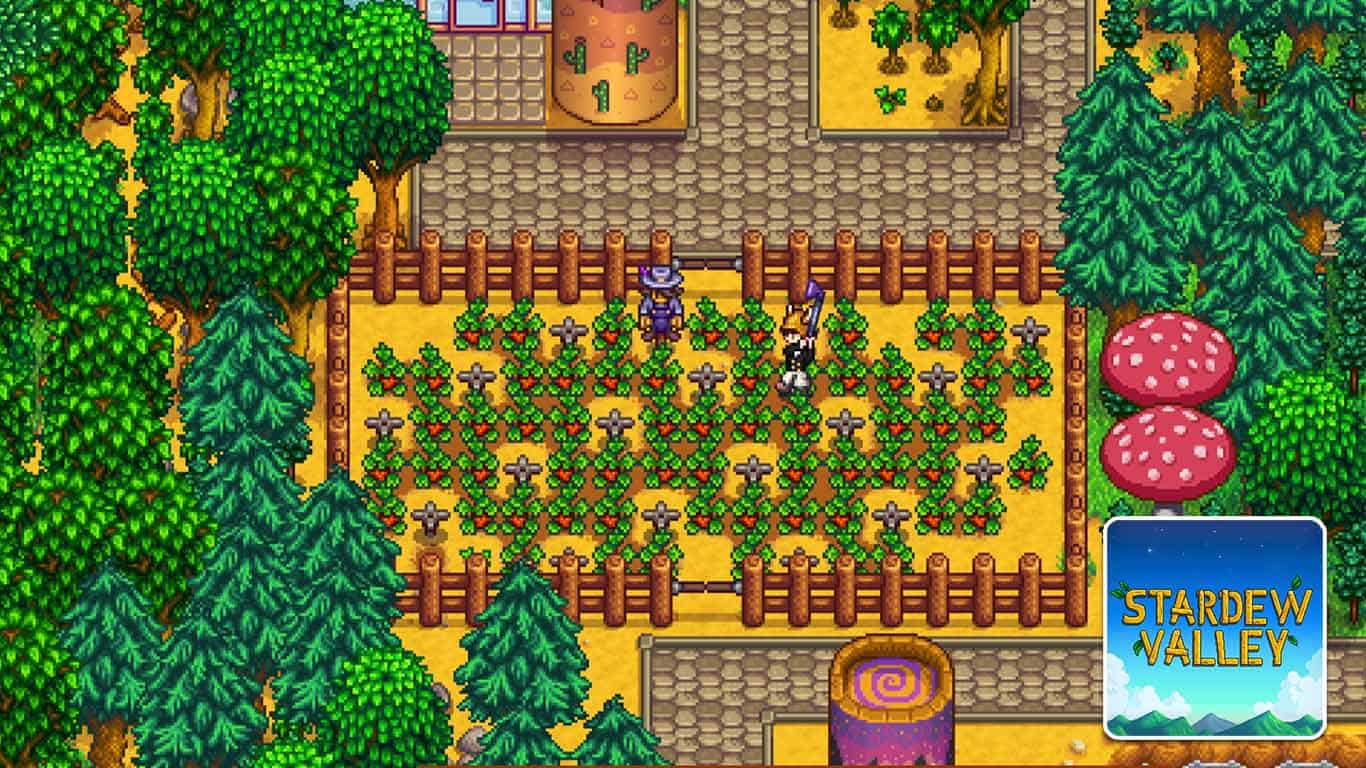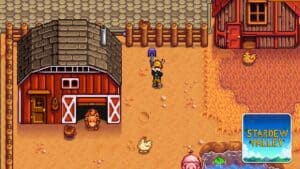There are 5 main skills in Stardew Valley that players will develop and level up to increase their monetary income and efficiency. However, there is only one skill that players consider vital to a successful playthrough, and that is Farming.
Farming is the best way to make money in Stardew Valley, it is the most relaxing way to advance through the game, and it is the main way you are supposed to spend your time in this life simulator.
Recommended Read: How to Get Tea Leaves in Stardew Valley
As you try to fix your grandfather’s farm, you will have to learn all the secrets of Farming: how the skill levels and XP work and how to actually do it.
In this guide, we will present everything there is to know about Farming in Stardew Valley, as well as how to farm, how skill XP works, and how to become the richest farmer in Pelican Town.
Table of Contents
- How to Farm in Stardew Valley (Simplified)
- How to Harvest in Stardew Valley
- Farming Skill Level and XP Explained
- Best Farming Methods and Techniques
How to Farm in Stardew Valley (Simplified)
We will first go through a simple, beginner-friendly explanation of how to farm in Stardew Valley:
In Stardew Valley, the basics of Farming are that you need to till the soil using a Hoe (hit the ground and turn a square into a darker shade of brown), plant any crop seeds, and water them every day until you get a harvest.
You will generally have to buy seeds from Pierre’s General Store, which is right in the middle of Pelican Town, east of your farm. It is impossible to miss, as it has a large sign that says “Pierre’s.”
Once you have seeds and tilled tiles where you can plant them, just approach the squares with the seeds in your hands (selected in the hotbar inventory) and interact with the ground to place them.
Your next step is to get water from a lake or river using your Watering Can. Just interact with a body of water while holding the Watering Can in your hands, and then go back to the crops to water them.
Players will have to water their crops every day until it grows and can be harvested. You can generally see a clear difference in how the crop looks, allowing you to figure out you can finally harvest it.
How to Harvest in Stardew Valley
To harvest your crops in Stardew Valley, you first have to wait for them to grow. Each crop has a different growth time, and it can vary from 7 days to 20.
You can generally see a clear difference in how the crop looks when it is ready to harvest.
If you hover your cursor over the crops, you will see a little green “+” sign, which shows you that they are ready to be harvested.
Depending on the crop, you will either have to click on them to harvest them, or you will have to cut them with your Scythe.
The most efficient way to harvest crops in Stardew Valley is to hold the seeds that you want to use to replace the old crops and press the Do Action button (right-click on PC) to harvest and plant the new seeds at the same time.
This is extremely efficient since time stops while you are going through the planting motion, allowing you to win some in-game time, even though you might be losing some in real life.
Farming Skill Level and XP Explained in Stardew Valley
All skills in Stardew Valley start at level 0 and have a maximum of 10 levels. With each level, you unlock new crafting recipes, and at levels 5 and 10, you get to choose Professions, which give you significant advantages.
Most the Professions will increase the value of goods that you can sell, procured using that skill. Farming Professions will allow you to make a lot of money from either artisan goods or animal products.
Usually, you would choose the Profession that matches your game style. However, the best choices for Farming are Tiller and Artisan since artisan goods are the most valuable items in Stardew Valley.
To level up in Farming in Stardew Valley, you will need to get Farming XP. Farming XP is gained by doing tasks related to farming.
Here is a list of the things you can do to increase Farming XP in Stardew Valley, along with the amount of you get from them:
- Harvest crops (4 to 64 XP per crop)
- Pet animals (5 XP)
- Milk Cows/Goats (5 XP)
- Shear Sheep (5 XP)
- Pick up animal products (5 XP)
Here is also how much XP you need to get each Farming level in Stardew Valley:
- Level 1 – XP Needed: 100, Total XP: 100
- Level 2 – XP Needed: 280, Total XP: 380
- Level 3 – XP Needed: 390, Total XP: 770
- Level 4 – XP Needed: 530, Total XP: 1300
- Level 5 – XP Needed: 850, Total XP: 2150
- Level 6 – XP Needed: 1150, Total XP: 3300
- Level 7 – XP Needed: 1500, Total XP: 4800
- Level 8 – XP Needed: 2100, Total XP: 6900
- Level 9 – XP Needed: 3100, Total XP: 10000
- Level 10 – XP Needed: 5000, Total XP: 15000
Benefits of Leveling Farming
Besides Professions and crafting recipes, players will gain more advantages from leveling up their Farming skill.
Both the Watering Can and the Hoe, the main tools of a farmer, consume 2 Energy each time you use them. With each level, you gain +1 Proficiency in Farming, which lowers the amount of Energy these two tools use by 0.1.
This means that, at level 10, you only use 1 Energy for using the Watering Can and Hoe. Using buffs from food, players can get even higher levels in Farming, with the maximum being 14. This means that you could use only 0.6 Energy each time you used the Watering Can and Hoe.
Most items in Stardew Valley have four types of quality: Normal, Silver, Gold, and Iridium. The higher the quality of an item, the higher the value.
Leveling up Farming in Stardew Valley also increases the chance that you will get higher-quality crops from harvests. At level 0, players have a 1% chance of getting a Gold quality crop. With every level, this chance increases by 2%.
At level 10 Farming, players have a 33% chance of getting Silver quality crops from harvests and 21% Gold quality. This is all without Fertilizer which might increase the chances.
All Crops Harvest XP Gain
Since all crops give you different XP yields, here is a list of all the crops in Stardew Valley and the amount of experience you get by harvesting them, ordered from the best crop XP-wise to the worst:
- Sweet Gem Berry – 64 XP per harvest
- Starfruit – 43 XP per harvest
- Ancient Fruit – 38 XP per harvest
- Pumpkin – 31 XP per harvest
- Pineapple – 30 XP per harvest
- Fairy Rose – 29 XP per harvest
- Red Cabbage – 28 XP per harvest
- Melon – 27 XP per harvest
- Rhubarb – 26 XP per harvest
- Cauliflower – 23 XP per harvest
- Artichoke – 22 XP per harvest
- Yam – 22 XP per harvest
- Amaranth – 21 XP per harvest
- Poppy – 20 XP per harvest
- Strawberry – 18 XP per harvest
- Kale – 17 XP per harvest
- Beet – 16 XP per harvest
- Taro Root – 16 XP per harvest
- Radish – 15 XP per harvest
- Summer Spangle – 15 XP per harvest
- Bok Choy – 14 XP per harvest
- Cactus Fruit – 14 XP per harvest
- Cranberries – 14 XP per harvest
- Grape – 14 XP per harvest
- Potato – 14 XP per harvest
- Sunflower – 14 XP per harvest
- Eggplant – 12 XP per harvest
- Garlic – 12 XP per harvest
- Tomato – 12 XP per harvest
- Blue Jazz – 10 XP per harvest
- Blueberry – 10 XP per harvest
- Corn – 10 XP per harvest
- Green Bean – 9 XP per harvest
- Hot Pepper – 9 XP per harvest
- Parsnip – 8 XP per harvest
- Tulip – 7 XP per harvest
- Unmilled Rice – 7 XP per harvest
- Hops – 6 XP per harvest
- Wheat – 6 XP per harvest
- Coffee Bean – 4 XP per harvest
Best Farming Methods and Techniques
Unfortunately, farming in Stardew Valley isn’t as easy as explained above.
Though you could just till land, plant seeds, and water them every day, there are many other things you will need to do to successfully get a good harvest.
Scarecrows
The first thing you will need to pay attention to is Crows. Crows are a horrible enemy that will come and eat some of your crops if you don’t place a Scarecrow next to your plants.
The Scarecrow protects a large area of 8×8 tiles around it. So, it will protect 8 crops to the left and right, and the range has a diagonal reach of 6 tiles.
Scarecrows are mandatory if you want to be a successful farmer since you will otherwise lose a lot of money for no reason.
You will get the recipe to craft Scarecrows once you reach level 1 Farming, which should be done if you finish the “tutorial” by growing the crops that Lewis gifts you.
Sprinklers
The next thing that most players care about is removing the watering process from their everyday schedule.
Watering crops every day is extremely annoying, and it will lose you a lot of Energy and time before you even get to do anything.
This is why Sprinklers are a lifesaver that all Stardew Valley farmers should use. You will unlock the Sprinklers at level 2 Farming, and they will automatically water your plants every day for you.
Unfortunately, Sprinklers have a really small watering range at their first level, allowing you to only plant crops right next to them. They only water 4 tiles at the start (the ones adjacent to them).
Luckily, players have discovered through the years a very efficient way to place your Sprinklers to be efficient with your farm and have a nice layout for them, as seen in the image below.

The black squares are the tiles where you should place the Sprinklers, and the blue and purple tiles are the areas where the Sprinklers will water your crops.
To make it simple to identify the region that each Sprinkler waters, we gave the watered tiles blue and purple colors.
As you can see, you will need to place a Sprinkler 1 tile up and two to the left to get the right distance between them.
If you want to place one below it, then you can go 2 tiles down and then one to the right.
If you have some basic chess knowledge, then you would know that the Sprinklers can be placed the same way a Knight moves.
Fertilizers
There are three types of Fertilizer you can use on crops in Stardew Valley that can improve the farming experience:
- Fertilizer
- Retaining Soil
- Speed-Gro
The Fertilizer will help increase the chance that the crops will be of a better quality when you harvest them.
The Retaining Soil will make sure that watered tiles will remain watered overnight. If you have Sprinklers, this fertilizer is relatively useless.
The Speed-Gro increases the growth speed of crops, getting you to harvest the crops faster than normal.
All of these Fertilizers can be used to make the farming process more efficient, and it will make your crops much more profitable.
That’s everything you need to know about how to farm in Stardew Valley!
Have any input or suggestions for this guide? Let us know in the comment section below.




